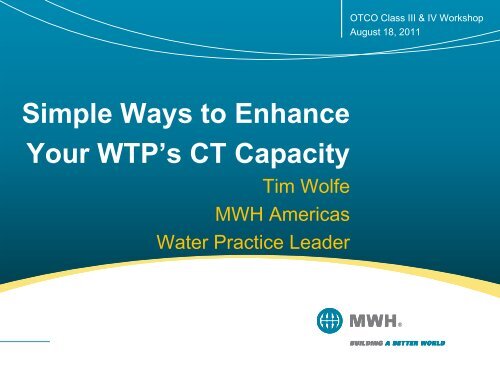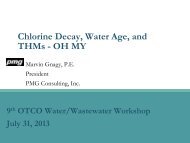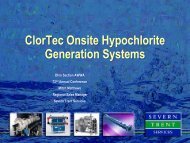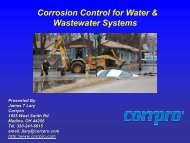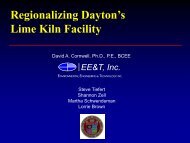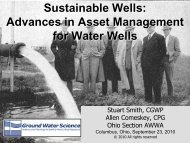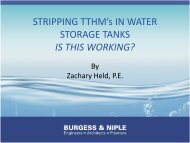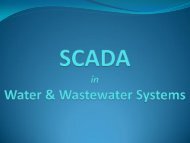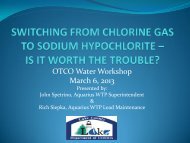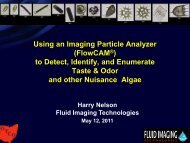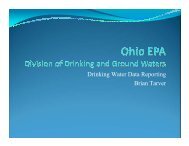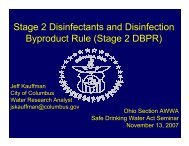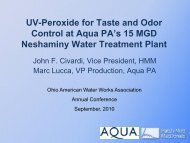Simple Ways To Enhance Your Water Treatment ... - Ohiowater.org
Simple Ways To Enhance Your Water Treatment ... - Ohiowater.org
Simple Ways To Enhance Your Water Treatment ... - Ohiowater.org
Create successful ePaper yourself
Turn your PDF publications into a flip-book with our unique Google optimized e-Paper software.
OTCO Class III & IV Workshop<br />
August 18, 2011<br />
<strong>Simple</strong> <strong>Ways</strong> to <strong>Enhance</strong><br />
<strong>Your</strong> WTP‟s CT Capacity<br />
Tim Wolfe<br />
MWH Americas<br />
<strong>Water</strong> Practice Leader
Items to be Discussed <strong>To</strong>day . . .<br />
• CT in Ohio EPA‟s Approved Capacity Document<br />
• Optimizing CT Credit in <strong>Your</strong> Clearwells<br />
• Lima‟s CT Credit <strong>Enhance</strong>ments<br />
• Avon Lake‟s Seasonal CT Credits
Clarified Need to Match (Normalize) Clearwell Component Capacity (i.e.,<br />
CT Capacity) with Other Components of the <strong>Water</strong> <strong>Treatment</strong> Plant (WTP)<br />
OHIO EPA‟s APPROVED<br />
CAPACITY DOCUMENT
Ohio EPA Plan-approval Letters<br />
Now State the:<br />
• Approved Capacity of the “<strong>Water</strong>-supply Source” is XX<br />
MGD – and the Limiting component on which the approved<br />
capacity is based,<br />
• Approved Capacity of the “WTP” is YY MGD – and the<br />
Limiting component on which the approved capacity is based,<br />
and<br />
• Approved Capacity of the “<strong>Water</strong> System” is XX or YY<br />
MGD – i.e., the smaller of the approved capacities for the<br />
<strong>Water</strong>-supply Source and WTP<br />
4
“Components” of<br />
<strong>Water</strong> <strong>Treatment</strong> Plants (WTPs)<br />
• A unit-treatment process (e.g., pre-sedimentation,<br />
rapid-mix, flocculation, sedimentation, filtration,<br />
stabilization, etc.);<br />
• Essential chemical storage-and-feed facilities;<br />
• Disinfection (e.g., chorine, chloramines, chlorine<br />
dioxide, ozone or UV generation and/or contacting<br />
facilities); and<br />
• WTP pumping (e.g., intermediate pumping<br />
between components within the WTP, finishedwater<br />
pumping to convey finished water to the<br />
distribution system, etc.).<br />
5
“Production” is the rate at which<br />
finished water leaves the WTP<br />
• “Customer water demands” are:<br />
– Commercial and Industrial (Large users)<br />
– Residential<br />
– Public use (Billed or Unbilled)<br />
• Most of the difference between WTP Production<br />
and Customer Demands is contributed to<br />
or supplied by distribution storage<br />
6
“Production” . . . (cont)<br />
• “Other items” that cause a difference between WTP<br />
Production and Customer Demands are:<br />
– Accounted-for and Unaccounted-for Distribution-system<br />
<strong>Water</strong> losses<br />
– Inaccurate meters<br />
– Etc.<br />
7
Each “Part” of a <strong>Water</strong> System Plays a<br />
Role in Supplying Customer Demands<br />
Source<br />
Avg.-day, or<br />
Max.-day<br />
Surface<br />
<strong>Water</strong><br />
Lakes<br />
Reservoirs<br />
Rivers<br />
Ground<br />
<strong>Water</strong><br />
Aquifers<br />
WTP<br />
Max.-day<br />
<strong>Water</strong><br />
<strong>Treatment</strong><br />
Disinfection &<br />
Finished-water<br />
Pumping<br />
Line between Production<br />
and Demands can be Blurry<br />
Instantaneous-peak,<br />
Fire-flow,<br />
Pk.-hour Demands,<br />
Etc.<br />
Comm/Ind<br />
Residential<br />
Public use<br />
Losses<br />
Inaccurate<br />
Meters<br />
Distribution System<br />
8
Distribution Storage is the Buffer<br />
Between Production and Demands<br />
Avg.-day, or<br />
Max.-day<br />
Surface<br />
<strong>Water</strong><br />
Lakes<br />
Reservoirs<br />
Rivers<br />
Ground<br />
<strong>Water</strong><br />
Aquifers<br />
WTP<br />
Production<br />
Max.-day<br />
<strong>Water</strong><br />
<strong>Treatment</strong><br />
Disinfection &<br />
Finished-water<br />
Pumping<br />
Pk<br />
hr<br />
Customer<br />
Demand, etc.<br />
Instantaneous-peak,<br />
Fire-flow Demands<br />
Storage<br />
Comm/Ind<br />
Residential<br />
Public use<br />
Losses<br />
Inaccurate<br />
Meters<br />
Distribution System<br />
9
Typical Ratios of Customer Demand<br />
to WTP Production<br />
• Avg.-day Demand<br />
Avg.-day Production = 1<br />
• Max.-day Demand<br />
Max.-day Production = approx. 1<br />
• Pk.-hour Demand<br />
Pk.-hour Production = > 1<br />
Most of the difference between Demand and Production is<br />
contributed to or supplied by distribution-system storage<br />
10
In Essence:<br />
Distribution-system Storage . . .<br />
. . . Provides the difference between:<br />
• The large, customer demands (e.g., Pk.-hour,<br />
Instantaneous-peak and Fire-flow), etc.<br />
AND<br />
• The smaller, more constant, rate at which water is<br />
produced on any given day at the WTP (i.e.,<br />
Production) to supply these various Customer<br />
Min.-day, Avg.-day, or Max.-day demands<br />
11
Storage Buffers Up- & Down-stream<br />
Flow Rates between Components<br />
Avg.-day<br />
Max.-day<br />
Max.-day<br />
Pk.<br />
hour<br />
<strong>Water</strong><br />
<strong>Treatment</strong><br />
Source-water<br />
Storage<br />
Clearwell<br />
Storage<br />
Finished-water<br />
Pumping<br />
“Source-water storage” allows upstream <strong>Water</strong>-supply source components<br />
to be designed to meet Avg.-day production (not Max.-day rates).<br />
Likewise, “Clearwell storage” allows upstream WTP components<br />
to be designed to meet Max.-day production (not Pk.-hour rates).<br />
12
WTP Production Projections<br />
for a Growing <strong>Water</strong> System<br />
Finished-water Pumping<br />
Finished<br />
<strong>Water</strong><br />
Production<br />
Projections<br />
( MGD )<br />
15.0<br />
13.5<br />
10.0<br />
7.5<br />
Pk.-hour Production<br />
Pk.-hour of <strong>Treatment</strong><br />
CT Criteria for Clearwells<br />
Max.-day Production<br />
Most WTP Components<br />
Avg.-day Production<br />
Most Source Components<br />
0<br />
<strong>To</strong>day<br />
Design<br />
Year<br />
13
Productions are Normalized around Max.-day<br />
Production to Calculate Equiv. Max.-day Cap.<br />
Finished<br />
<strong>Water</strong><br />
Production<br />
Projections<br />
( MGD )<br />
15.0<br />
13.5<br />
10.0<br />
7.5<br />
Pk.-hour Production<br />
Pk.-hour of <strong>Treatment</strong><br />
Max.-day Production<br />
Avg.-day Production<br />
0<br />
<strong>To</strong>day<br />
Design<br />
Year<br />
14
For <strong>Water</strong>-supply Components that<br />
Supply Avg.-day WTP Production . . .<br />
. . . The Component Capacity is converted to an<br />
“Equivalent Max.-day Capacity” by:<br />
„Multiplying‟ the Component Capacity by the ratio of<br />
Max.-day to Avg.-day production:<br />
E.g., an aquifer’s safe yield (i.e., component capacity) is 5.0<br />
MGD, and the water system’s ratio of Max.-day to Avg.-day<br />
production is 1.25:<br />
5.0 MGD Avg.-day 1.25 Max.-day<br />
------------------------- X ------------------- = 6.25 MGD Equiv. Max.-day<br />
1 Avg.-day<br />
15
For WTP Components that Supply<br />
Pk.-hr WTP Production . . .<br />
. . . The Component Capacity is converted to an<br />
“Equivalent Max.-day Capacity” by:<br />
„Dividing‟ the Component Capacity by the ratio of<br />
Pk.-hr to Max.-day production:<br />
E.g., the Component (CT) capacity for the Clearwell<br />
is 12.5 MGD for a 10-MGD WTP, and the water<br />
system’s ratio of Pk.-hr “production” to Max.-day<br />
production is 1.5:<br />
12.5 MGD Pk.- hr X Max.-day = 8.3 Equiv. Max.-day<br />
1 1.5 Pk.-hr<br />
16
The Clearwells for this 10-MGD WTP are the<br />
Limiting Component in Year X<br />
15.0<br />
Pk.-hour Production<br />
Finished<br />
<strong>Water</strong><br />
Production<br />
Projections<br />
( MGD )<br />
12.5<br />
10.0<br />
8.3<br />
7.5<br />
Max.-day Production<br />
Avg.-day Production<br />
0<br />
<strong>To</strong>day<br />
Year<br />
X<br />
Design<br />
Year<br />
17
YES – a Clearwell (i.e., CT capacity) can be a<br />
WTP‟s Limiting Component<br />
First thing this water system can do to increase Component<br />
capacity of the Clearwell is to use Pk.-hr of <strong>Treatment</strong> instead<br />
of Pk.-hour Production for daily CT calculations<br />
(i.e., Production generally > <strong>Treatment</strong> during Pk.-hr conditions,<br />
and <strong>Water</strong> level in Clearwell is typically dropping)<br />
Pk.-hr of<br />
<strong>Treatment</strong><br />
Pk.-hr<br />
Production<br />
CT = residual disinfectant Concentration x effective contact Time<br />
T is based on pk.-hr of treatment and corresponding clearwell level<br />
18
Using Pk.-hr treatment Increases<br />
Equiv. Max.-day from 8.3 to 9.3 MGD<br />
I.e., the CT capacity of the Clearwell is still 12.5 MGD,<br />
but the water system’s ratio of Pk.-hr “treatment” to<br />
Max.-day production is 1.35:<br />
13.5 MGD Pk.- hr Trtmnt = 1.35<br />
10.0 MGD Max.-day<br />
12.5 MGD Pk.- hr X Max.-day = 9.3 Equiv. Max.-day<br />
1 1.35 Pk.-hr<br />
19
And . . . The Clearwell CT Capacity<br />
now becomes Limiting in Year Y<br />
Finished<br />
<strong>Water</strong><br />
Production<br />
Projections<br />
( MGD )<br />
15.0<br />
13.5<br />
12.5<br />
10.0<br />
9.3<br />
7.5<br />
Pk.-hour Production<br />
Pk.-hour <strong>Treatment</strong><br />
Max.-day Production<br />
Avg.-day Production<br />
0<br />
<strong>To</strong>day<br />
Year<br />
Y<br />
Design<br />
Year<br />
20
<strong>To</strong> Increase the CT Capacity, the<br />
<strong>Water</strong> System could also . . .<br />
• Increase the “C” of CT by increasing the free<br />
chlorine residual (i.e., CT values req’d are higher,<br />
but DBPs don’t form as readily in the winter)<br />
• Increase the “T” of CT by maintaining a higher<br />
water level in the Clearwells (e.g., install VFDs on<br />
finished-water pumps)<br />
• Increase the “T” of CT by increasing the effective<br />
volume factor, EVF, of the Clearwells (e.g., install<br />
baffles, etc.)<br />
21
Additional Baffles Increased the<br />
EVF from 0.4 to 0.6 and CT Cap.<br />
I.e., the Equiv. Max.-day capacity of the Clearwell is<br />
9.3 MGD, but the EVF is now 0.6 instead of 0.4:<br />
9.3 MGD Equiv. Max.-day X 0.6 = 14.0 Equiv. Max.-day<br />
1 0.4<br />
Now – the Clearwell component capacity no longer limits the<br />
Approved Capacity of this 10-MGD WTP<br />
22
<strong>To</strong> Increase the Approved Capacity,<br />
the <strong>Water</strong> System could also . . .<br />
• Decrease the “Ratio” of Pk.-hour of treatment to<br />
Max.-day water production (e.g., install VFDs on<br />
both source-water and finished-water pumps),<br />
• Decrease the “Ratio” of Pk.-hour water production<br />
to Max.-day water production (e.g., construct<br />
additional distribution-system storage),<br />
• Request a “seasonal CT” approved capacity for<br />
the Clearwells (particularly if the Summer, Max.-<br />
day water production is significantly larger than the<br />
Winter, Max.-day water production)<br />
23
OPTIMIZING CT CREDIT IN<br />
YOUR CLEARWELLS
Effective Volume Factor (EVF)<br />
Increasing Effective Volume<br />
Factor (EVF) – Baffles<br />
0.8<br />
0.6<br />
0.4<br />
Available on the Ohio EPA Website<br />
0.2<br />
10:1 20:1 30:1 40:1<br />
Length to Width (L:W) Ratio
Typical Baffled Clearwell<br />
length of pass ( l ) = 10 W<br />
From<br />
the<br />
Filters<br />
Baffles<br />
Width of pass ( W ) = W<br />
<strong>To</strong>tal Length ( L ) = 3 ( l ) = 3 ( 10 W ) = 30 W<br />
F-w<br />
Pumps<br />
Side <strong>Water</strong> Depth ( SWD ) = 1.25 W<br />
From<br />
the<br />
Filters<br />
Baffles<br />
3 W<br />
Length to Width ( L : W ) Ratio = 30 : 1
Increasing EVF<br />
Flow-Through Inlet Wall<br />
8 to 10 %<br />
of the wall<br />
is openings<br />
for the influent<br />
to the clearwell<br />
to flow through
Inlet Wall Installed near Point of<br />
Clearwell Influent Flow<br />
length of pass ( l ) = 10 W<br />
Flow-Through Inlet Wall<br />
W<br />
<strong>To</strong>tal Length ( L ) = 3 ( l ) = 3 ( 10 W ) = 30 W<br />
Side <strong>Water</strong> Depth ( SWD ) = 1.25 W<br />
3 W<br />
Flow-Through Inlet Wall<br />
Length to Width ( L : W ) Ratio = 30 : 1
Increasing EVF - Turning Vanes<br />
length of pass ( l ) = 10 W<br />
W<br />
Turning Vanes<br />
<strong>To</strong>tal Length ( L ) = 3 ( 10 W ) = 30 W<br />
Side <strong>Water</strong> Depth ( SWD ) = 1.25 W<br />
Turning Vanes<br />
3 W<br />
Length to Width ( L : W ) Ratio = 30 : 1
Increasing EVF - Summary<br />
Bottom Line is to Increase EVF to a value as<br />
close to 1 as possible:<br />
By<br />
• Maximizing plug-flow regions<br />
And<br />
• Minimizing completely-mixed flow regions<br />
• Minimizing dead spaces
LIMA‟s CT CREDIT<br />
ENHANCEMENTS
Lima is Installing Post-filter GAC to Control<br />
T&O and as a DBP Buffer (i.e., to meet LRAA)<br />
SMALL CLEARWELL<br />
<strong>To</strong><br />
Distribution<br />
0-3 MGD<br />
LARGE<br />
CLEARWELL<br />
EVF = 0.2<br />
EVF = 0.375<br />
0-17 MGD<br />
From<br />
Filters<br />
OLD CLEARWELL<br />
Flow<br />
Control<br />
0-20 MGD New Baffles<br />
GAC<br />
0-40 MGD<br />
EVF = 0.3
Finished-<br />
<strong>Water</strong><br />
Pump Sta.<br />
Filters, and<br />
Clearwells<br />
Underneath<br />
New GAC<br />
Contactors<br />
Location<br />
Old<br />
Clearwell
Existing Clearwell System<br />
Presents Some Challenges<br />
<strong>To</strong> Lima‟s Distribution<br />
System<br />
Finished-water<br />
Pump Station<br />
Large<br />
Clearwell<br />
No. 2<br />
From the<br />
Dual-media<br />
Filters<br />
Small<br />
C.W. No. 1<br />
Old Clearwell No. 3<br />
has same influent &<br />
effluent pipe<br />
Old<br />
Clearwell<br />
No. 3<br />
High chlorine residuals required to meet winter-time CT values.
Lima‟s WTP has an Approved<br />
Capacity of 30 MGD<br />
Projected, Design-year Parameters:<br />
– Pk.-hour production = 40.0 MGD *<br />
– Max.-day production = 30.0 MGD<br />
– Avg.-day production= 22.5 MGD<br />
= 1.33<br />
= 1.33<br />
* For calculation of daily CT values, the Pk.-hour of<br />
treatment (i.e., clearwell influent) is assumed to be<br />
equal to Pk.-hour production (i.e., clearwell effluent, or<br />
the finished-water pumping rate)
Intermediate Pumping was Required @ Lima<br />
WTP to Convey Filter Effluent through GAC<br />
Two Clearwells No. 1 & 2 located beneath filters<br />
Ten (10)<br />
Dual-Media<br />
Filters<br />
Four (4) New, GAC Contactors<br />
(with 10 ft depth of GAC)<br />
New, 36-in. tie-in with two<br />
Clearwells beneath filters<br />
New, Intermediate Pump-station<br />
New, 36-in. tie-in<br />
With Old Clearwell No. 3
Intermediate Pumping Presented<br />
Opportunity to <strong>Enhance</strong> CT Cap.<br />
– New 36-in. pipeline from GAC to old clearwell No. 3:<br />
• eliminates potential T&O issues<br />
• allows clearwells No. 1 – 3 to be operated in series<br />
– New 36-in. pipeline from GAC to small clearwell No. 1:<br />
• allows clearwells No. 1 & 2 to be operated in parallel with old<br />
clearwell No. 3<br />
– Control valve with flow meter in small clearwell No. 1<br />
influent pipe:<br />
• allows clearwells to be isolated and cleaned in the summer
Finished-<br />
<strong>Water</strong><br />
Pump Sta.<br />
Filters, and<br />
Clearwells<br />
Underneath<br />
New GAC<br />
Contactors<br />
Location<br />
Old<br />
Clearwell<br />
New 36-in. dia.<br />
Connection to<br />
Old Clearwell
Benefit / Cost Ratio for these<br />
Additional Pipelines was Significant<br />
Finished-water<br />
Pump Station<br />
<strong>To</strong> Lima‟s<br />
Distribution<br />
System<br />
Large<br />
Clearwell<br />
No. 2<br />
Small<br />
C.W. No. 1<br />
New,<br />
36-in. Pipeline<br />
Old Clearwell<br />
No. 3<br />
From GAC
Baffling of Old CW No. 3 and Large CW No. 2<br />
Provided a True 30-MGD Approved Capacity<br />
– Baffling of old clearwell No. 3 increases effective<br />
volume factor (EVF) to 0.3 without a tracer study (i.e.,<br />
length-to-width [L:W] ratio = 10.5)<br />
– Baffling of large clearwell No. 2 increases EVF to 0.375<br />
without a tracer study (L:W ratio = 14.5)
Pipelines and Baffles Provide Several<br />
Advantages for CT Capacity @ Lima WTP<br />
Finished-water<br />
Pump Station<br />
<strong>To</strong> Lima‟s<br />
Distribution<br />
System<br />
From GAC<br />
Large<br />
Clearwell<br />
No. 2<br />
Small<br />
C.W. No. 1<br />
Recommended<br />
Baffles<br />
New,<br />
36-in. Pipeline<br />
Flow in<br />
only one<br />
direction<br />
Old Clearwell<br />
No. 3
Design-year Winter CT values can be met at<br />
a Cl 2 Residual of only 1.8 mg/L<br />
• CT CALCULATIONS<br />
– Worst-Case Conditions:<br />
• <strong>Water</strong> Temperature (C) = 4<br />
• Max pH Value > 9<br />
• Cl2 residual (mg/L) =1.8<br />
– Max CT Value Required – Winter (mg/L-min) = 63.3<br />
• CT values achieved at 40 MGD (Design-year,<br />
Pk.-hour production for Lima‟s 30-MGD WTP):<br />
– Clearwells in Series: 64.7 mg/L-min<br />
– Clearwells in Parallel: 63.3 mg/L-min
Clearwell Flow-path Changes<br />
Provide Lima Advantages:<br />
– Increase currently limited CT capacity of existing<br />
Clearwells (i.e., a cost-effective, side-benefit since<br />
intermediate pumping is required anyway for the postfilter,<br />
GAC adsorption units)<br />
– Eliminate dead-spaces in existing, Old Clearwell No. 3<br />
(i.e., GAC-treated water would now enter and exit Old<br />
Clearwell No. 3 at different points)<br />
– Allow a Clearwell to be taken out-of-service for<br />
maintenance during warm weather (i.e., Since CT<br />
values are easier to meet in warm weather, and<br />
Clearwells can now be operated in parallel)
AVON LAKE‟s SEASONAL CT<br />
CREDITS
Avon Lake Municipal Utilities Serves the<br />
City and Numerous Other Communities<br />
Avon<br />
Lake‟s<br />
WTP<br />
Avon Lake‟s<br />
Distribution<br />
System<br />
RLCWA‟s<br />
Extended<br />
Distribution<br />
System<br />
Served<br />
by Avon Lake
Avon Lake‟s WTP Serves a System with<br />
Growing Estimated Demands (Max.-day)<br />
Year<br />
City’s<br />
System<br />
Extended<br />
System<br />
<strong>To</strong>tal<br />
2000 5.0 26.6 31.6<br />
2005 5.1 31.7 36.8<br />
2010 5.3 36.6 41.9<br />
2015 5.4 41.6 47.0<br />
2020 5.6 46.5 52.1
Summer / Winter Approved Capacities<br />
were in Place for Avon Lake‟s WTP<br />
Based on a full-scale Demonstration study:<br />
• The Summer approved capacity was 40 MGD<br />
• The Winter approved capacity was 36 MGD<br />
(i.e., winter water production was not yet high<br />
enough to demonstrate 20 MGD through one of<br />
the two existing, 18-MGD rapid-mix units)
CT is more difficult to meet in the Winter<br />
• Winter CT req’d = 51 mg/L-min<br />
• Summer CT req’d = 27 mg/L-min<br />
• pH = 8<br />
• Temp: Winter = 0.5 C Summer = 10 C<br />
• Chlorine residual = 1.1 mg/L<br />
• 0.5-log inactivation of Giardia
Winter Clearwell Component Capacity was<br />
Limiting WTP Capacity<br />
Volume (MG)<br />
(@ min. Depth)<br />
Clearwells Clearwells All<br />
1-4 5-6 Clearwells<br />
0.4 1.0 1.4<br />
E.V.F 0.2 0.5<br />
Max CT Req’d 51 51<br />
Component<br />
Cap. (MGD)<br />
5 40 45
Equivalent Max.-day Capacities were really<br />
Challenging<br />
• Pk.-hour to Max.-day Ratio = 1.35<br />
• Therefore, Equiv. Max.-day Capacities were:<br />
45 MGD Max.-day<br />
X<br />
1 1.35 Pk.-hour<br />
= 33 MGD (winter)<br />
85 MGD Max.-day<br />
X<br />
1 1.35 Pk.-hour<br />
= 63 MGD (summer)
Without Seasonal Capacities: Ohio EPA<br />
Plan-approval Letter would have Stated . . .<br />
• Approved Capacity of Pretreatment at the WTP is 36 MGD<br />
• Equiv. Max.-day CT Capacity of the Clearwells is 33 MGD<br />
• Approved Capacity of WTP is 33 MGD<br />
51
With Seasonal Capacities:<br />
Ohio EPA Plan-approval Letter Stated . . .<br />
• Approved Capacity of Pretreatment at the WTP is 40 MGD<br />
Summer<br />
• Approved Capacity of Pretreatment at the WTP is 36 MGD<br />
Winter<br />
• Equiv. Max.-day CT Capacity of the Clearwells is 63 MGD<br />
Summer<br />
• Equiv. Max.-day CT Capacity of the Clearwells is 33 MGD<br />
Winter<br />
• Approved Capacity of WTP is 40 MGD Summer<br />
• Approved Capacity of WTP is 33 MGD Winter<br />
52
First Tracer Study was Performed<br />
on an Isolated Clearwell 5<br />
Sampling<br />
Point<br />
Central<br />
High<br />
North<br />
High<br />
4<br />
3<br />
2<br />
Clearwells<br />
1<br />
5 6<br />
F: 0 - 1.0 mg/L<br />
Sampling<br />
Point<br />
From Filters
8:00<br />
8:30<br />
9:00<br />
9:30<br />
10:00<br />
10:30<br />
11:00<br />
11:30<br />
12:00<br />
12:30<br />
13:00<br />
13:30<br />
14:00<br />
C/Co<br />
1<br />
Clearwell 5: Graphical Method<br />
0.9<br />
0.8<br />
0.7<br />
E.V.F. = 1.80 / 2.47 hrs = 0.73<br />
0.6<br />
0.5<br />
0.4<br />
0.3<br />
0.2<br />
T= 1.80 Hrs<br />
0.1<br />
0<br />
Time
log(1-C/Co)<br />
0.0<br />
Clearwell 5: Numerical Method<br />
-0.1<br />
-0.2<br />
-0.3<br />
-0.4<br />
-0.5<br />
-0.6<br />
-0.7<br />
E.V.F. = 0.785<br />
-0.8<br />
-0.9<br />
-1.0<br />
-1.1<br />
-1.2<br />
0.0 0.2 0.4 0.6 0.8 1.0 1.2 1.4 1.6 1.8 2.0<br />
t/T
Tracer Study on Clearwells 1 – 4<br />
was Performed Next<br />
Central<br />
High<br />
F 0.5 mg/L<br />
North<br />
High<br />
4<br />
3<br />
Sampling<br />
Point<br />
2<br />
Clearwells<br />
1<br />
5 6<br />
Sampling<br />
Point<br />
F 0.8 mg/L<br />
From Filters
12:00<br />
12:30<br />
13:00<br />
13:30<br />
14:00<br />
14:30<br />
15:00<br />
15:30<br />
16:00<br />
16:30<br />
17:00<br />
17:30<br />
18:00<br />
18:30<br />
19:00<br />
19:30<br />
20:00<br />
20:30<br />
21:00<br />
21:30<br />
22:00<br />
Fluoride (mg/L)<br />
Start 13:50<br />
15:22 (T10=92 min.)<br />
1.4<br />
Clearwells 1 - 4: Graphical Method<br />
1.3<br />
1.2<br />
1.1<br />
1<br />
0.9<br />
10% of Test Range<br />
0.8<br />
0.7<br />
0.6<br />
E.V.F. = 92 / 168 min = 0.55<br />
0.5<br />
Time<br />
Influent Effluent Avg. Inffl. 90% Retention Curve
log(1-C/Co)<br />
0<br />
Clearwells 1 - 4: Numerical Method<br />
-0.1<br />
-0.2<br />
-0.3<br />
-0.4<br />
-0.5<br />
-0.6<br />
E.V.F. = 0.55<br />
-0.7<br />
-0.8<br />
-0.9<br />
-1<br />
0 0.2 0.4 0.6 0.8 1 1.2 1.4 1.6 1.8 2 2.2 2.4 2.6<br />
t/<strong>To</strong><br />
log(1-C/Co) Linear T10
EVFs and Clearwell Component Capacity<br />
Increased After Tracer Studies<br />
Volume (MG)<br />
(@ min. Depth)<br />
Clearwells Clearwells All<br />
1-4 5-6 Clearwells<br />
0.4 1.0 2.2<br />
E.V.F. 0.55 0.7<br />
Max CT Req’d 51 51<br />
Component<br />
Cap. (MGD)<br />
14 55 69
Equivalent Max.-day Capacities were No<br />
Longer Challenging<br />
• Pk.-hour to Max.-day Ratio = 1.35<br />
• Therefore, Equiv. Max.-day Capacities are:<br />
69 MGD Max.-day<br />
X<br />
1 1.35 Pk.-hour<br />
= 51 MGD (winter)<br />
130 MGD Max.-day<br />
X<br />
1 1.35 Pk.-hour<br />
= 96 MGD (summer)
Without Seasonal Capacities: Ohio EPA<br />
Plan-approval Letter would have Stated . . .<br />
• Approved Capacity of Pretreatment at the WTP is 36 MGD<br />
• Equiv. Max.-day CT Capacity of the Clearwells is 51 MGD<br />
• Approved Capacity of WTP is 36 MGD<br />
61
With Seasonal Capacities:<br />
Ohio EPA Plan-approval Letter Stated . . .<br />
• Approved Capacity of Pretreatment at the WTP is 40 MGD<br />
Summer<br />
• Approved Capacity of Pretreatment at the WTP is 36 MGD<br />
Winter<br />
• Equiv. Max.-day CT Capacity of the Clearwells is 96 MGD<br />
Summer<br />
• Equiv. Max.-day CT Capacity of the Clearwells is 51 MGD<br />
Winter<br />
• Approved Capacity of WTP is 40 MGD Summer<br />
• Approved Capacity of WTP is 36 MGD Winter<br />
62
. . . Items that were Discussed <strong>To</strong>day<br />
• CT in Ohio EPA‟s Approved Capacity Document<br />
• Optimizing CT Credit in <strong>Your</strong> Clearwells<br />
• Lima‟s CT Credit <strong>Enhance</strong>ments<br />
• Avon Lake‟s Seasonal CT Credits


